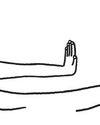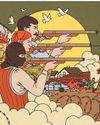
In September, Pope Francis became the first leader of the Catholic Church ever to visit Mongolia. It must have been a humbling stopover. The country has fewer than fifteen hundred Catholics. The welcoming ceremony, in Ulaanbaatar’s main square, attracted a few hundred spectators—a crowd less than a thousandth the size of one that had gathered to see him in Lisbon a month earlier. One of the attendees had come out to do his morning Tai Chi and unknowingly ended up at the event.
Not everyone understood why the Pontiff was there. A caterer at a banquet for the Vatican entourage asked a Times reporter, “What are Catholics again?” But the Pope came prepared. Speaking to diplomats, cultural leaders, and the Mongolian President, he celebrated the religious freedom protected under the Mongol Empire during the thirteenth and fourteenth centuries—“the remarkable ability of your ancestors to acknowledge the outstanding qualities of the peoples present in its immense territory and to put those qualities at the service of a common development.” He also celebrated “the Pax Mongolica,” the period of Mongol-enforced stability across Eurasia, citing its “absence of conflicts” and respect “of international laws.”
この記事は The New Yorker の January 01 - 08, 2023 (Double Issue) 版に掲載されています。
7 日間の Magzter GOLD 無料トライアルを開始して、何千もの厳選されたプレミアム ストーリー、9,000 以上の雑誌や新聞にアクセスしてください。
すでに購読者です ? サインイン
この記事は The New Yorker の January 01 - 08, 2023 (Double Issue) 版に掲載されています。
7 日間の Magzter GOLD 無料トライアルを開始して、何千もの厳選されたプレミアム ストーリー、9,000 以上の雑誌や新聞にアクセスしてください。
すでに購読者です? サインイン

NOW YOU SEE ME
John Singer Sargent's strange, slippery portraits of an art dealer's family.

PARIS FRIEND - SHUANG XUETAO
Xiaoguo had a terror of thirst, so he kept a glass of water on the table beside his hospital bed. As soon as it was empty, he asked me to refill it. I wanted to warn him that this was unhealthy - guzzling water all night long puts pressure on the kidneys, and pissing that much couldn't be good for his injury. He was tall, though, so I decided his insides could probably cope.

WILD SIDE
Is Lake Tahoe's bear boom getting out of hand?

GETTING A GRIP
Robots learn to use their hands.

WITHHOLDING SEX FROM MY WIFE
In the wake of [the] election, progressive women, who are outraged over Donald Trump's victory at the ballot box, have taken to social media with public, vengeful vows of chastity. - The Free Press.

DEADLINE EXTENSION
Old age, reborn.

THE TEXAS EXODUS
Amid stringent abortion laws, ob-gyns are fleeing the state.

GET IT TOGETHER
In the beginning was the mob, and the mob was bad. In Gibbon’s 1776 “Decline and Fall of the Roman Empire,” the Roman mob makes regular appearances, usually at the instigation of a demagogue, loudly demanding to be placated with free food and entertainment (“bread and circuses”), and, though they don’t get to rule, they sometimes get to choose who will.

GAINING CONTROL
The frenemies who fought to bring contraception to this country.

REBELS WITH A CAUSE
In the new FX/Hulu series “Say Nothing,” life as an armed revolutionary during the Troubles has—at least at first—an air of glamour.